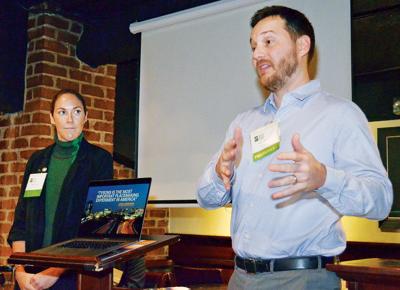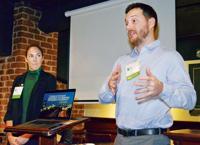It’s not easy to wow local business people accustomed to watching high-rise office, hotel and residential buildings sprout up all over Tysons, but representatives from the Tysons Partnership managed it with just one projected slide.
Speaking Oct. 11 at a Greater McLean Chamber of Commerce breakfast, the partnership’s Drew Sunderland and Meghan Trossen projected a slide sequence showing Tysons as it is, buildings now under construction and – the clincher – a cluster of vertical red rectangles representing approved developments, largely located between Capital One’s campus and Pimmit Hills.
Trossen and Sunderland assured those present that all those massive redevelopments are not occurring in isolation, but are part of a multi-pronged plan to build “America’s Next Great City.”
Tysons covers about 4.2 square miles (roughly the same size as the town of Vienna) and already is home to 50.8 million square feet of development, which makes it the 12th or 13th largest U.S. office-space market. But county officials also have approved an additional 43.9 square feet of development.
Tysons is being redeveloped under a comprehensive plan approved in 2010 by the Fairfax County Board of Supervisors.
Much development in Tysons will be centered within one-quarter mile of four stations on Metro’s Silver Line. County officials did not set density limits in those close-in areas and one such site, The View, one day may be the site of a skyscraper more than 600 feet tall.
Many infrastructure improvements in the burgeoning urban area are being financed through proffers granted by developers, along with tax revenues from a local service district. When development levels reach trigger points outlined in the comprehensive plan, new schools, fire and police stations, athletic fields and other facilities will need to be built.
Transportation improvements also will be a key factor in Tysons’ success. Some developers already have begun implementing a new grid of streets that will give motorists, pedestrians and bicyclists other options besides a few traffic-clogged major streets.
Capital Bikeshare already has 12 stations in Tysons and two more are on the way, Sunderland said.
“We’ve been pleasantly surprised by the usage,” he said. “Ridership is up 18 percent in the last year.”
One woman at the meeting said more needed to be done to ensure cyclists’ safety.
“You take your life in your hands coming to Tysons,” she said.
Tysons is home to the headquarters of five Fortune 500 companies, and many workers in the community want to take Metro to their jobs, Trossen said.
“We want to start changing behavior and changing traffic now,” she said.
The Jones Branch Connector, which will span the Beltway between Jones Branch Drive and Route 123 at Capital One’s camps, will have one lane open in each direction by early next year, Sunderland and Trossen said.
One concept being pondered is putting roadways underground at the interchange of Routes 7 and 123, building public open space above and freeing up land now hemmed in by asphalt cloverleafs for further development, Sunderland said.
Planners also have talked about the possibility of constructing a right-turns-only “superstreet” along Route 123 south of the Capital One campus.
Parks and recreation will be a key part of Tysons’ future success, the presenters said. A network of parks already is taking shape, and county officials hope those sites can be linked so bicyclists and pedestrians will be able to commute through them, taking more vehicles off the road.
Local sports organizations and community officials also have pressed developers hard to build sufficient athletic fields in Tysons so as to keep facilities in surrounding areas from being overwhelmed.
The Tysons Partnership also supports efforts to create distinctive neighborhoods in Tysons’ eight districts, the presenters said.
These efforts may prove challenging, if Merrifield is any example. Cities with well-known neighborhoods (such as New York, Boston and Chicago) have seen those areas grow organically over many decades, but Merrifield’s Mosaic District and surrounding redevelopments still are trying to create a genuine sense of community, according to some observers.
One way to foster community, as well as decrease confusion, is to encourage companies to change their business signatures (which, depending on which side of Route 7 they’re located on, could be McLean or Vienna) to say “Tysons,” Sunderland said.
In addition, Tysons Partnership leaders favor the introduction of affordable housing so teachers, public-safety personnel and other middle-class employees can live in Tysons as well as work there.
“Tysons will not be successful unless workforce and affordable housing are addressed,” Sunderland said.


